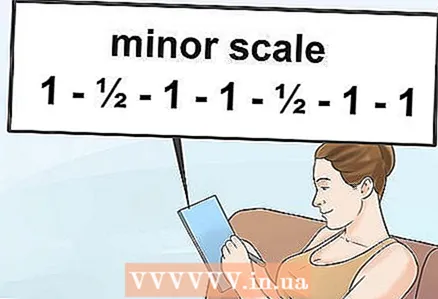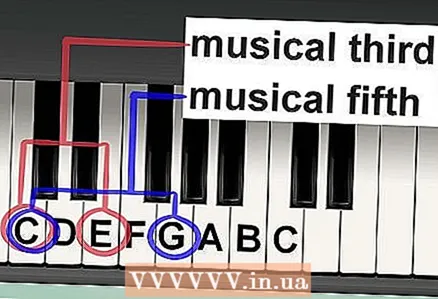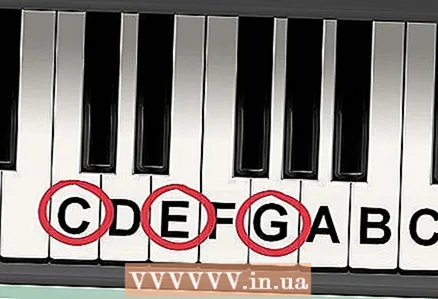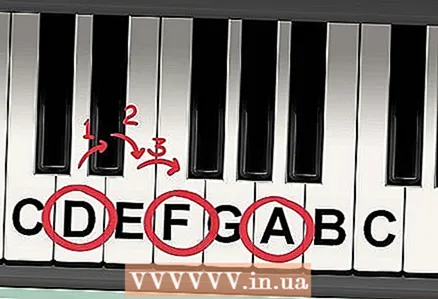Author:
Helen Garcia
Date Of Creation:
14 April 2021
Update Date:
14 May 2024

Content
- Steps
- Part 1 of 3: Introducing Some Musical Terms
- Part 2 of 3: Reading Notes to Determine Key
- Part 3 of 3: Determining the key by ear
- Tips
The ability to identify in which key a song or piece of music is being played is a very useful musical skill. Knowing the key will give you the ability to transpose the song (change the key) to match your voice. You can also experiment with giving songs different sounds (a great skill for creating a successful cover version of a song). To determine the key of a song, you will need to grasp some basic concepts of music theory. The piano is the simplest instrument that can be used as an example to explain and understand these concepts.
Steps
Part 1 of 3: Introducing Some Musical Terms
 1 The concept of musical intervals and semitones. Halftones and intervals is the distance between two notes. They are a kind of building blocks in the musical scale.
1 The concept of musical intervals and semitones. Halftones and intervals is the distance between two notes. They are a kind of building blocks in the musical scale. - Scale is a sequence of sounds in ascending order. They form an octave, a set of eight notes (from lat. octavus, which means "eighth"). For example, here is a major scale in the key of C major: C D E F G A B C. The bottom note of the scale is called "tonic".
- If you think of the scale described above as a staircase, each semitone will be one notch higher than the last. Thus, the distance between B and C is a semitone, because there are no other "steps" between them (on the piano, the B and C keys are white and are located next to each other, there are no black keys between them). But the distance from C to D is a full interval, because on the stairs between these notes there is an additional "rung" (that is, a black piano key, which is a C sharp or D flat).
- In the key of C major, semitones are only between B and C, and also between E and F. All other intervals are complete, because the scale in C major does not have sharp (#) or flat (♭) signs in the key.
 2 The concept of major scales. The major scale has the same pattern for full intervals (1) and semitones (½): 1 - 1 - ½ - 1 - 1 - 1 - ½. Thus, the C major scale is designated C D E F G A B C.
2 The concept of major scales. The major scale has the same pattern for full intervals (1) and semitones (½): 1 - 1 - ½ - 1 - 1 - 1 - ½. Thus, the C major scale is designated C D E F G A B C. - You can create any other major scale by changing the starting note (root note) and following the interval pattern.
 3 The concept of minor scales. Minor scales are more complex than major scales and can follow several patterns. The most common minor scale pattern is natural minor.
3 The concept of minor scales. Minor scales are more complex than major scales and can follow several patterns. The most common minor scale pattern is natural minor. - The pattern of intervals and semitones of the natural minor scale is as follows: 1 - ½ - 1 - 1 - ½ - 1 - 1.
- You can transpose the pattern of this scale (that is, rewrite it in a different tone) by starting at a different note and going up the “rungs” of your scale ladder.
 4 The concept of musical thirds and fifths. The third and fifth are variations of the musical interval (distance between notes) that are common in music. They can be useful for determining the key of the music. Minor intervals contain semitones less than major ones, which is why there is a change in sound.
4 The concept of musical thirds and fifths. The third and fifth are variations of the musical interval (distance between notes) that are common in music. They can be useful for determining the key of the music. Minor intervals contain semitones less than major ones, which is why there is a change in sound. - The third is formed by the first and third notes in the key. A major third contains two full intervals between notes, while a minor third contains only three semitones.
- The fifth is formed by the first and fifth notes of the key. A clean fifth contains seven semitones.
- If you've heard Leonardo Cohen's song Hallelujah, then you've already heard about the musical intervals in the next line: “It goes like this, the fourth, the fifth, the minor fall, the major lift, the baffled king composing‘ Hallelujah ’”. In many works of pop music (often written in the key of C major), a chord progression from "fourth" (fourth) to "fifth" (fifth) is visible, which creates a "joyful" sound. In the song, the words "minor fall" are accompanied by a minor chord, and the words "major lift" are accompanied by a major chord.
 5 Major chords concept. The main chord consists of three notes, called a triad, arranged in thirds (see step 4 for more details). These chords are usually based on a scale such as C major. Major scales contain two full intervals between the first and second notes of the triad. A major chord contains a major third and a clean fifth. The first note of a chord is called the “root” of the chord.
5 Major chords concept. The main chord consists of three notes, called a triad, arranged in thirds (see step 4 for more details). These chords are usually based on a scale such as C major. Major scales contain two full intervals between the first and second notes of the triad. A major chord contains a major third and a clean fifth. The first note of a chord is called the “root” of the chord. - For example, to play a chord based on the C major scale, you can start with the C, root, and use that as the root of your chord. Then move up to the third of this scale (4 semitones higher) to E, then up to the fifth of the scale (one and a half steps higher to G). C - E - G and will make up the major chord triad.
 6 Minor chords concept. The quality of most chords is determined by the third, or center note, in a triad. Minor chords contain one and a half intervals between the first and second notes of a triad, as opposed to four semitones (or two full intervals) of major chords. The minor chord contains a minor third and a clean fifth.
6 Minor chords concept. The quality of most chords is determined by the third, or center note, in a triad. Minor chords contain one and a half intervals between the first and second notes of a triad, as opposed to four semitones (or two full intervals) of major chords. The minor chord contains a minor third and a clean fifth. - For example, if you place your fingers one key above the root note of a C major chord, you get the following chord: D - F - A. This chord is a minor D major chord, because the interval between the first and second notes of a chord (D and F ) will be three semitones.
 7 The concept of enlarged and reduced chords. These chords are not as common as major or minor chords, but they are sometimes used to create special effects. Thanks to their changes to familiar triads, they create a melancholic, ominous or eerie sound.
7 The concept of enlarged and reduced chords. These chords are not as common as major or minor chords, but they are sometimes used to create special effects. Thanks to their changes to familiar triads, they create a melancholic, ominous or eerie sound. - A diminished chord contains a minor triad and a diminished fifth (a fifth dropped by a semitone). For example, here's what a diminished C chord would look like: C - E ♭ - G ♭.
- An enlarged chord contains a major third and an enlarged fifth (a fifth raised by a semitone). For example, here's what an enlarged C chord would look like: C - E - G #.
Part 2 of 3: Reading Notes to Determine Key
 1 Determine the key sign. With notes printed, you can determine the key of a song by looking at it key mark... It is a set of small marks between the clef (treble or bass) and the time stamp (numbers that look like beats).
1 Determine the key sign. With notes printed, you can determine the key of a song by looking at it key mark... It is a set of small marks between the clef (treble or bass) and the time stamp (numbers that look like beats). - You will see either # (sharp) or ♭ (flat).
- If neither # nor ♭ is listed, the song is in either the key of C major or A major.
 2 Reading sheet music. For key characters using flats, the key character is at the penultimate flat mark (second from the right) when the notes are read from left to right.
2 Reading sheet music. For key characters using flats, the key character is at the penultimate flat mark (second from the right) when the notes are read from left to right. - When a song has flat marks in B ♭, E ♭, and A ♭ - E ♭ is the penultimate flat mark, which means the piece is in the key of E flat.
- If there is only one flat, then the song is performed in either C minor or F major.
 3 Reading notes with sharps. For key marks using sharps, the key mark is a note that is one half interval higher than the last sharp mark.
3 Reading notes with sharps. For key marks using sharps, the key mark is a note that is one half interval higher than the last sharp mark. - When sharps in a song are in F # and C #, the next note up from C # is D, which means the piece is in the key of D major.
 4 Check the tablature. If you play the guitar, then when you learn a new melody, you will most likely refer to the tablature. Many songs begin and end with a key chord. If the piece ends in D major, it is most likely performed in the key of D major.
4 Check the tablature. If you play the guitar, then when you learn a new melody, you will most likely refer to the tablature. Many songs begin and end with a key chord. If the piece ends in D major, it is most likely performed in the key of D major. - There are three basic chords in the key of C major: C major (C - E - G), F major (F - A - C), and G major (G - B - D). These three chords form the basis of most pop songs.
 5 Learn several scales. Knowing a few common scales in your style of music will help you figure out what key your song is in. All notes from the chord will be in your scale.
5 Learn several scales. Knowing a few common scales in your style of music will help you figure out what key your song is in. All notes from the chord will be in your scale. - For example, an F major chord is F - A - C, and all of these notes are in the C major scale, so the F major chord is in the key of C major.
- The A major chord (A - C # - E) is not in the key of C major, because the C major scale does not include sharps.
 6 Make an educated guess. Most popular tunes often use one of the few simple keys because they are easy to play on the guitar or piano, which are often used as accompaniment instruments.
6 Make an educated guess. Most popular tunes often use one of the few simple keys because they are easy to play on the guitar or piano, which are often used as accompaniment instruments. - Today, C major is the most popular key for pop songs.
- Take a look at the sequence of notes that make up the C major scale: C - D - E - F - G - A - B - C. Do the notes in the melody correspond to the notes in the scale? If so, then the song is most likely performed in the key of C major.
 7 Look for signs of alteration. You should remember that melodies sometimes have alteration signs, that is, notes marked with a ♭ or # in the melody, even if the key sign does not indicate that the note must necessarily take ♭ or #.
7 Look for signs of alteration. You should remember that melodies sometimes have alteration signs, that is, notes marked with a ♭ or # in the melody, even if the key sign does not indicate that the note must necessarily take ♭ or #. - Alteration signs do not affect the overall tonality of the piece.
Part 3 of 3: Determining the key by ear
 1 Determine the tonic note. The tonic, which is the first note in the scale, will sound right at any moment of the song. Using the piano or your own voice, play one note at a time until you find the one that "matches" the song.
1 Determine the tonic note. The tonic, which is the first note in the scale, will sound right at any moment of the song. Using the piano or your own voice, play one note at a time until you find the one that "matches" the song.  2 Check your tonic. By playing other notes in the triad, you can tell by ear whether the chord is right for the song. Play the fifth note over what you think is the tonic. This note should also fit into most of the song, as it is the second most stable note in the scale.
2 Check your tonic. By playing other notes in the triad, you can tell by ear whether the chord is right for the song. Play the fifth note over what you think is the tonic. This note should also fit into most of the song, as it is the second most stable note in the scale. - Play a note one semitone below the tonic known as the "seventh." You should feel some tension in the context of the song, as if the note “wants” to take the place of the tonic.
 3 Determine if the song is written in a major or minor key. Play a note that is a larger third higher from the tonic. If this note fits into the overall motive of the song, then it is likely that the melody is in a major key. If not, try playing the minor third (3 ♭) and see if it fits better.
3 Determine if the song is written in a major or minor key. Play a note that is a larger third higher from the tonic. If this note fits into the overall motive of the song, then it is likely that the melody is in a major key. If not, try playing the minor third (3 ♭) and see if it fits better. - Learn to distinguish between major and minor triads by playing the major triad with C as the root note: C - E - G.Now replace E with E ♭ to make C - E ♭ - G. Notice the difference in overall motive and atmosphere.
- By the nature of the melody, it is quite possible to determine whether it is major (large) or minor (small), because in most Western songs performed in minor, sadness and melancholy can be traced.
 4 Check out a few chords. The most common chords within a scale should also appear in song patterns. One of the commonly used scales is G major, which continues to follow the pattern of the major scale: G - A - B - C - D - E - F # - G. Its chords are G major, A minor, B minor, C major, D major, in E minor and reduced in F sharp major.
4 Check out a few chords. The most common chords within a scale should also appear in song patterns. One of the commonly used scales is G major, which continues to follow the pattern of the major scale: G - A - B - C - D - E - F # - G. Its chords are G major, A minor, B minor, C major, D major, in E minor and reduced in F sharp major. - Songs in the key of G major will contain chords corresponding to those notes.
- For example, Green Day's song “(Good Riddance) Time of Your Life” starts with a G major chord (G - B - D) followed by a C major chord (C - E - G). Both of these chords are in the G major scale, which means that the song is performed in the key of G major.
 5 Sing along to the songs. Pay attention to songs that are easier for you to sing along, instead of songs that seem unusually high or low to you. Memorize the key of songs that you sing with ease and that you sing with difficulty.
5 Sing along to the songs. Pay attention to songs that are easier for you to sing along, instead of songs that seem unusually high or low to you. Memorize the key of songs that you sing with ease and that you sing with difficulty. - Over time, you will realize that some keys are in your range, while others will be difficult to reach all the notes. This will help you to roughly determine the key even before you play the melody on the instrument.
 6 Practice the acquired skill. Add some of your favorite songs to the player, or turn on the radio and try to determine the key of the song. Very soon, you will start to notice some patterns. Songs of the same key will become similar to each other for you.
6 Practice the acquired skill. Add some of your favorite songs to the player, or turn on the radio and try to determine the key of the song. Very soon, you will start to notice some patterns. Songs of the same key will become similar to each other for you. - Create a list of the songs you've learned, categorizing them by key.
- Listen to several songs in a row in the same key to learn how to identify that key.
- Add songs in a different key to see if you can tell the difference.
 7 Evaluate the results. If you want to write your own songs or adapt other people's songs for yourself, then knowing the basics of music theory will come in handy, but sometimes you just need to quickly find out the key of the song. There are many mobile apps and websites that can help you determine the key of a song.
7 Evaluate the results. If you want to write your own songs or adapt other people's songs for yourself, then knowing the basics of music theory will come in handy, but sometimes you just need to quickly find out the key of the song. There are many mobile apps and websites that can help you determine the key of a song. - Search by song title and key to get an answer as quickly as possible.
- When you learn to determine the key of songs by ear, double-check the correctness of your conclusions.
Tips
- Listen to songs that you know the key and try to find the chords that sound in them. The more you practice and practice your ear, the easier it will be for you to identify the key of a song.
- There is a huge amount of potentially confusing terminology from music theory in this article, but once you get down to plotting scales and chords on a real instrument, things will become clearer to you.



